
THE PATH FROM HATE TO LOVE
WILLIAM JOHNSTON, S.J.
‘No peace
between the nations without peace between the religions’, the theologian Hans
Küng has said. And how can that be achieved? Pondering the
terrorist attacks on the United States, a Jesuit skilled in
East-West dialogue sees only one answer. Article originally
published in The Tablet and reproduced here with
permission from the Editor and the Author. It gives the
Japanese/Buddhist response to the theology of Julian
of Norwich .

hen I returned to Japan
from Europe last November, I had an opportunity to speak to
a group of Japanese friends about the crisis in today’s
world. All agreed that the attack on the World Trade Centre
was a turning-point in the history of humanity. The world
will never again be the same.
Many Japanese who watched that seemingly innocent plane head relentlessly towards its target in the blue sky of New York were reminded of another turning-point in human history. On 6 August 1945 at 8.15 in the morning a tiny silver plane appeared high in the cloudless blue sky of Hiroshima. People looked up in wonder. And then it parachuted down, the bomb that killed 100,000 people and left 100,000 wounded, blinded, paralysed, their naked bodies scorched from head to toe. That day of terror ushered in the nuclear age.
In my many decades in Japan I have encountered little bitterness, little talk of revenge. The Japanese seldom speak about the bomb. Nevertheless now, more than 50 years after that unspeakable tragedy, it is legitimate to ask if there is any connection between the ruthless destruction of the Twin Towers in New York and the cruel bomb that wiped out Hiroshima.
The thesis of Samuel Huntington about the clash of civilisations is well known in Japan, where it has been widely discussed both in learned journals and in popular magazines. As my friends and I sat around a table drinking green tea, we began to speak about the clash of civilisations in this country. We reflected on the bloody clash that took place when Christianity came to Japan in the sixteenth century. The new religion, brought by St Francis Xavier, was at first warmly welcomed. In Nagasaki thousands joyfully received baptism, and the missionaries were filled with confidence. But the rulers of Japan began to see Christianity as a threatening colonial power, and after unleashing one of the fiercest persecutions in human history, they expelled all foreigners. For centuries Japan was cut off from the world, with only a few Dutch residents remaining in "the closed country".
And what about today?
We agreed that the clash of civilisations continues in the hearts of the people, particularly in the hearts of Japanese Christians. It is described dramatically by the distinguished Japanese novelist Shusaku Endo. A committed Catholic with a personal love for Jesus Christ, Endo brought many Japanese to baptism, yet he felt uncomfortable with the exterior trappings of Western Christianity. He, a Japanese, was wearing Western clothing. His vocation in life was to change that Western suit into a Japanese kimono.
Asked concretely what the problem was, Endo replied that Christianity was too much a Western religion. It was dogmatic, uncompromising, patriarchal. It saw reality in terms of black-and-white. Its history was full of "I am right and you are wrong", bringing inquisitions, intolerance, punishment of dissidents and downright lack of compassion.
Asian thought, on the other hand, was
"grey", flexible, tolerant. It stressed "both-and" rather than
"either-or". Above all, Asian thought was feminine, grounded
in a predominantly yin culture. Endo often said that his faith
came through his mother. I recall showing him a book about Julian of Norwich and "the motherly
love of Jesus". He smiled enthusiastically. "Father, give me
that book!" he said.
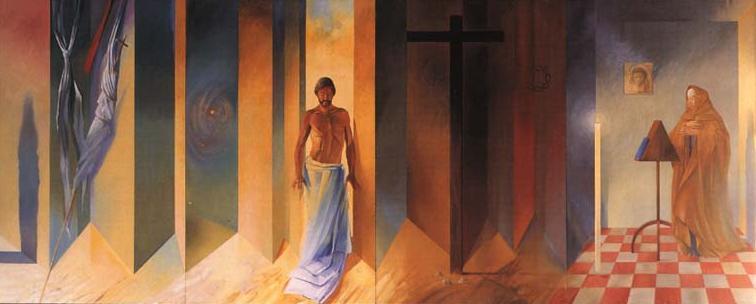
The illustration is taken from the painting of
Julian's Showings in St Gabriel's Chapel, Community of
All Hallows, Ditchingham, Near Bungay, Suffolk. Painted by the
Australian artist, Alan Oldfield, it was earlier exhibited in
Norwich Cathedral; photographed, Sister Pamela, C.A.H.
© Reproduced by permission of
the Community of All Hallows and the Friends of Julian.
The clash of civilisations in Asia has indeed been fierce. Colonialism and religion are at its core.
As we move into the third millennium, however, one great event gives ground for optimism: the clash between Buddhism and Christianity is becoming a powerful dialogue in which both religions are mutually enriched. Christians listen attentively to the wise words of the Dalai Lama and Sogyal Rinpoche; they learn meditation from Thich Nhat Hanh and Zen teachers. Likewise, Buddhist teachers quote the gospels, and Buddhist scholars in Kyoto have made profound studies of the Christian mystics, particularly Meister Eckhart. And all this is complemented by cooperation in helping the poor and in working for world peace. Here there is real friendship.
And this raises the million-dollar question: can the Buddhist-Christian dialogue become a model for dialogue between the religions of the world? Can we all work together so that the clash of civilisations becomes a union of civilisations?
Let me mention two aspects of Buddhism that are valuable yet controversial.
The first is that while it has a wealth of teaching, Buddhism has no dogma. Buddhist teaching is upaya, a Sanskrit word usually translated into English as "skilful means", leading to an enlightenment like that of the Buddha. In itself it is not absolute truth but pragmatic truth. So the Buddhist teacher will willingly use the New Testament or the scriptures of any religion provided they lead to enlightenment, which makes Buddhism very tolerant; but it can lead to a clash with Jewish, Christian or Islamic civilisations.
I believe that upaya (translated into Japanese as hoben) penetrates Asian society. Shusaku Endo, it seems to me, had something of hoben, and this was part of his struggle. He was deeply committed to Jesus Christ; but for him (and I hope I do him justice) the Church was a skilful means.
My second point is that Buddhism is a mystical religion which leads beyond words and thinking and reasoning to the silence of "transcendental wisdom". Buddhists teach meditation, whether through the repetition of the name or the contemplation of a mandala or the regulation of the breath. Their mystics, like many Christian mystics, enter into the emptiness, the darkness, the nothingness, the cloud of unknowing.
What can we – Christians, Jews, Muslims – learn from these two aspects of Buddhism?
Assuredly we cannot abandon all dogma; but we can be less dogmatic. We can abandon fundamentalism, and recognise that much of our teaching is "pragmatic truth". Already we Catholics (if I may say it modestly) have become more tolerant, open to dialogue, open to compromise, open to recognising the goodness and truth in others. We can now learn from others and recognise our mistakes. But we have a long way to go.
For this uncompromising attitude which is basically religious – common to traditional Judaism, Christianity and Islam – extends to the whole of Western thinking; and it played its part in the annihilation of Hiroshima. Think of the Second World War. The stance of the Allied powers could be summed up as: "We want unconditional surrender. We are good and our enemies are evil. We will have no truck with evil. We will have no negotiation, no dialogue, no talking, no mercy." The result was the carpet bombing of the German cities and the terrible destruction of Japan. Men, women, children and animals died in Hiroshima and Nagasaki. Even the mosquitoes were wiped out. In the fire bombing of Tokyo 100,000 people, almost all civilians, died.
No one in any official position apologised for Hiroshima and Nagasaki; and it would be idle to deny the existence of the same uncompromising mentality today. "No negotiation with terrorists" is the slogan. "We are good: terrorists are evil. Anyone who harbours a terrorist or shows any understanding will pay the price. Shoot to kill! Show no mercy!" And (horror of horrors!) this attitude often has the blessing of religious authorities.
Now the frightening thing is that the Islamic fundamentalists who destroyed the Twin Towers have the same way of thinking. They, too, believe they are pitted against evil. They want to destroy the corrupt Western civilisation. They want no negotiation and they will consider no dialogue. They will show no mercy. They will die rather than compromise. It is no secret that they are working might and main to get weapons of mass destruction. For them the attacks in New York and Washington were only the first step.
And so we are faced with a very terrible confrontation. Is there any answer?
I find it difficult to see an answer for the immediate future; but for the distant future there is surely an answer.
The answer, the only answer, is dialogue and friendship between the religions, a dialogue in which the religions will challenge one another, lead one another to conversion of heart and help one another get away from fanatical fundamentalism. Through these means we will all find our authentic roots in love and compassion. Bernard Lonergan rightly says that all true religion is based on love; and he maintains that religious conversion is conversion to love.
Interreligious dialogue is the way of the future. There is now a Parliament of Religions which meets every year, working for a global ethic that will outlaw war and terrorism and killing. The indefatigable Pope John Paul has travelled the world, seeking union between the Catholic Church and other religions. Who can doubt that the Holy Spirit is working in human hearts?
And there is a further movement, from dialogue to prayer. This was already clear in 1986 when representatives of the religions prayed for peace at Assisi; and John Paul made the extraordinary statement that the exigencies of peace transcend religion. The same Pope longs for the day when Jews, Muslims and Christians will unite in common prayer to our father Abraham. And the day will surely come – indeed it has already come – when children of East and West will unite in silent, mystical prayer at the core of our being.
We used to say that dialogue between the religions is necessary for world peace. Now we can say that dialogue between the religions is necessary for world survival. Only prayerful dialogue between Judaism, Christianity, Islam, Hinduism and Buddhism can save our planet from destruction. What a responsibility we have!
We concluded our meeting last November by speaking about a Japanese Christian prophet and mystic who lost his all in the holocaust of Nagasaki. Dr Takashi Nagai worked tirelessly for the sick and wounded until he collapsed and could work no more. As he lay dying of leukaemia he cried out that war in the nuclear age would be suicide for humanity: "From this atomic waste the people of Nagasaki confront the world and cry out: No more war! Let us follow the commandment of love and work together. The people of Nagasaki prostrate themselves before God and pray: grant that Nagaski may be the last atomic wilderness in the history of the world."
Japanese Christians are rightly proud of their
prophetic Takashi Nagai.
Irish Fr William Johnston SJ was based at Sophia University in Tokyo.
Indices to Umiltà
Website's Julian Essays:
Preface
Influences
on Julian
Her Self
Her
Contemporaries
Her Manuscript
Texts ♫ with recorded readings of them
About Her
Manuscript Texts
After
Julian, Her Editors
Julian in our
Day
Publications related to Julian:
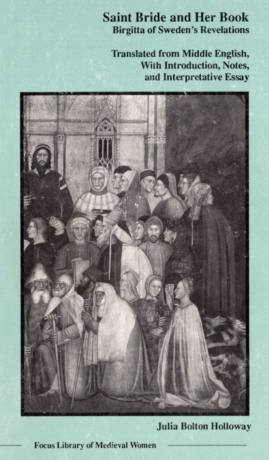

Saint Bride and Her Book: Birgitta of Sweden's Revelations Translated from Latin and Middle English with Introduction, Notes and Interpretative Essay. Focus Library of Medieval Women. Series Editor, Jane Chance. xv + 164 pp. Revised, republished, Boydell and Brewer, 1997. Republished, Boydell and Brewer, 2000. ISBN 0-941051-18-8
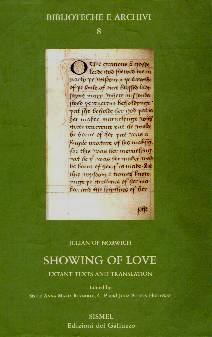 To see an example of a
page inside with parallel text in Middle English and Modern
English, variants and explanatory notes, click here. Index to this book at http://www.umilta.net/julsismelindex.html
To see an example of a
page inside with parallel text in Middle English and Modern
English, variants and explanatory notes, click here. Index to this book at http://www.umilta.net/julsismelindex.html
Julian of
Norwich. Showing of Love: Extant Texts and Translation. Edited.
Sister Anna Maria Reynolds, C.P. and Julia Bolton Holloway.
Florence: SISMEL Edizioni del Galluzzo (Click
on British flag, enter 'Julian of Norwich' in search
box), 2001. Biblioteche e Archivi
8. XIV + 848 pp. ISBN 88-8450-095-8.
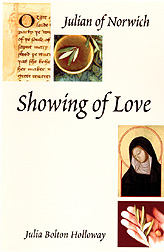 To see inside this book, where God's words are
in red, Julian's in black, her
editor's in grey, click here.
To see inside this book, where God's words are
in red, Julian's in black, her
editor's in grey, click here.
Julian of
Norwich. Showing of Love. Translated, Julia Bolton
Holloway. Collegeville:
Liturgical Press;
London; Darton, Longman and Todd, 2003. Amazon
ISBN 0-8146-5169-0/ ISBN 023252503X. xxxiv + 133 pp. Index.
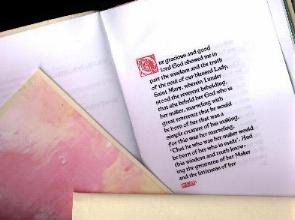 To view sample copies, actual
size, click here.
To view sample copies, actual
size, click here.

'Colections'
by an English Nun in Exile: Bibliothèque Mazarine 1202.
Ed. Julia Bolton Holloway, Hermit of the Holy Family. Analecta
Cartusiana 119:26. Eds. James Hogg, Alain Girard, Daniel Le
Blévec. Salzburg: Institut für Anglistik und Amerikanistik
Universität Salzburg, 2006.
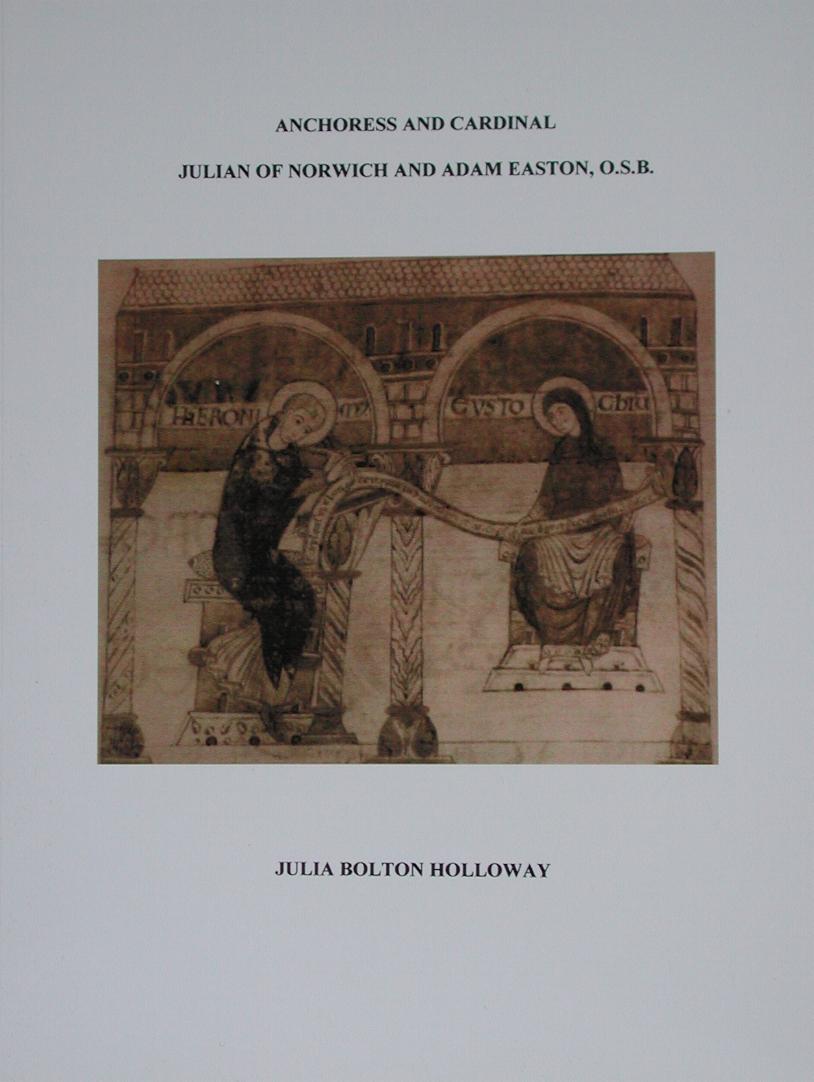
Anchoress and Cardinal: Julian of
Norwich and Adam Easton OSB. Analecta Cartusiana 35:20 Spiritualität
Heute und Gestern. Salzburg: Institut für Anglistik und
Amerikanistik Universität Salzburg, 2008. ISBN
978-3-902649-01-0. ix + 399 pp. Index. Plates.
Teresa Morris. Julian of Norwich: A
Comprehensive Bibliography and Handbook. Preface,
Julia Bolton Holloway. Lewiston: Edwin Mellen Press, 2010.
x + 310 pp. ISBN-13: 978-0-7734-3678-7; ISBN-10:
0-7734-3678-2. Maps. Index.

Fr Brendan
Pelphrey. Lo, How I Love Three: Divine Love in
Julian of Norwich. Ed. Julia Bolton Holloway. Amazon,
2013. ISBN 978-1470198299

Julian among
the Books: Julian of Norwich's Theological Library.
Newcastle upon Tyne: Cambridge
Scholars Publishing, 2016. xxi + 328 pp. VII Plates, 59
Figures. ISBN (10): 1-4438-8894-X, ISBN (13)
978-1-4438-8894-3.

Mary's Dowry; An Anthology of
Pilgrim and Contemplative Writings/ La Dote di
Maria:Antologie di
Testi di Pellegrine e Contemplativi.
Traduzione di Gabriella Del Lungo
Camiciotto. Testo a fronte, inglese/italiano. Analecta
Cartusiana 35:21 Spiritualität Heute und Gestern.
Salzburg: Institut für Anglistik und Amerikanistik
Universität Salzburg, 2017. ISBN 978-3-903185-07-4. ix
+ 484 pp.
| To donate to the restoration by Roma of Florence's
formerly abandoned English Cemetery and to its Library
click on our Aureo Anello Associazione:'s
PayPal button: THANKYOU! |
JULIAN OF NORWICH, HER SHOWING OF LOVE AND ITS CONTEXTS ©1997-2024 JULIA BOLTON HOLLOWAY || JULIAN OF NORWICH || SHOWING OF LOVE || ST BIRGITTA OF SWEDEN || BIBLE AND WOMEN || EQUALLY IN GOD'S IMAGE || MIRROR OF SAINTS || BENEDICTINISM || THE CLOISTER || ITS SCRIPTORIUM || AMHERST MANUSCRIPT || HEAVEN WINDOW || CATALOGUE (HANDCRAFTS, BOOKS ) || BOOK REVIEWS || BIBLIOGRAPHY ||
